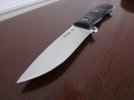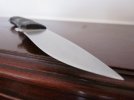- Joined
- Dec 1, 2007
- Messages
- 3,798
I just wanted to give you all a heads up regarding the use of the CABSLE for woodcraft tasks. Note that all I am about to say is my own experience and if I'm an idiot then so be it...
My primary bushcraft knives have always had flat scandi, convex scandi, or full convex edges (I tried a v-ground edge once and never went back). All of these edge geometries seemed to be easy to control - I knew where the edge was, where it was going, and when it would get there. In short, they would all do as I expected but with varying degrees of exertion on my part, based on grind type and thickness.
Then I tried the CABSLE. I've never used a thin, highly polished blade with a full flat grind and a blended convex edge before, and the combination is efficient to a degree I've never seen before. The convex edge bites hard and the flat grind guides that edge through both hard and soft woods like they were warm butter. The lack of sharp angle transitions accelerates this slicing action like nothing I've ever seen. I noticed yesterday that this geometry seems to locate grain pattern in wood like a heat-seeking missile and will go much farther and faster than I intended. The result was two sticks and a deeply bitten finger where I was supposed to have one notched stick and a mechanically-intact anatomy.
The moral: the amount of pressure I exert on a full convex knife or even a full flat knife is WAY too much pressure for a knife with a CABSLE-style grind. The CABSLE requires a new learning curve to prevent me from mangling myself - my advice is to start slowly and lightly and DO NOT treat it like a standard bushcraft knife as you may learn the hard way that it is in a class of its own.
The blood has been cleaned off and after three strops on each side it's hair-whittling sharp and ready for more. Hopefully next time it doesn't decide it wants more of me.
My primary bushcraft knives have always had flat scandi, convex scandi, or full convex edges (I tried a v-ground edge once and never went back). All of these edge geometries seemed to be easy to control - I knew where the edge was, where it was going, and when it would get there. In short, they would all do as I expected but with varying degrees of exertion on my part, based on grind type and thickness.
Then I tried the CABSLE. I've never used a thin, highly polished blade with a full flat grind and a blended convex edge before, and the combination is efficient to a degree I've never seen before. The convex edge bites hard and the flat grind guides that edge through both hard and soft woods like they were warm butter. The lack of sharp angle transitions accelerates this slicing action like nothing I've ever seen. I noticed yesterday that this geometry seems to locate grain pattern in wood like a heat-seeking missile and will go much farther and faster than I intended. The result was two sticks and a deeply bitten finger where I was supposed to have one notched stick and a mechanically-intact anatomy.
The moral: the amount of pressure I exert on a full convex knife or even a full flat knife is WAY too much pressure for a knife with a CABSLE-style grind. The CABSLE requires a new learning curve to prevent me from mangling myself - my advice is to start slowly and lightly and DO NOT treat it like a standard bushcraft knife as you may learn the hard way that it is in a class of its own.
The blood has been cleaned off and after three strops on each side it's hair-whittling sharp and ready for more. Hopefully next time it doesn't decide it wants more of me.


